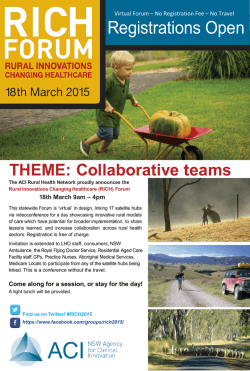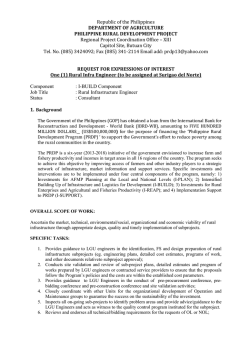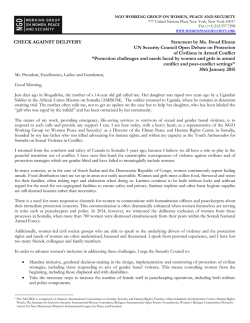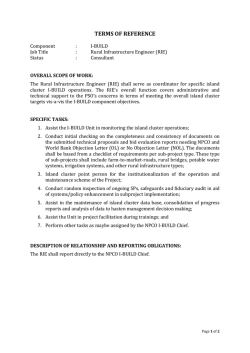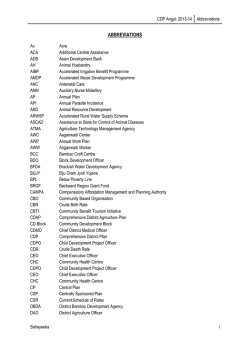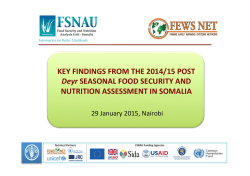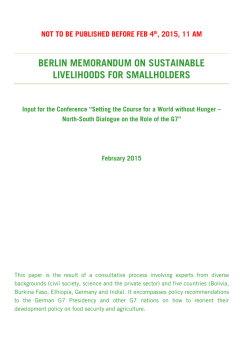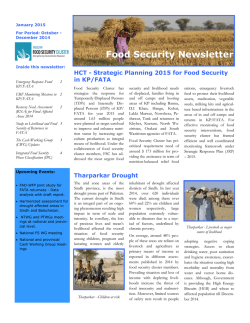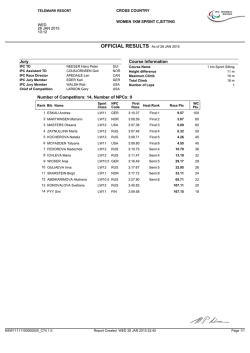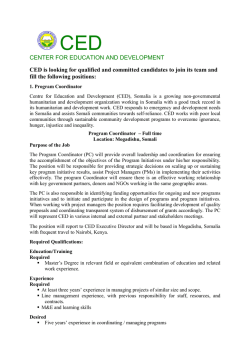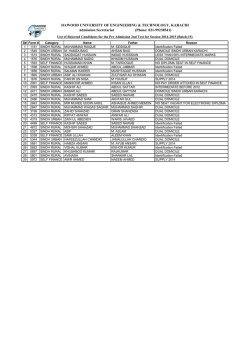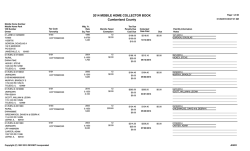
FSNAU Technical Release, January 29, 2015: Over 730000 people
Technical Release Over 730,000 people across Somalia face acute food insecurity despite improvements in some areas Nearly 203,000 children are acutely malnourished January 29, 2015, Nairobi/Washington – Despite improved food security following the Deyr harvest, improved livestock conditions, and mostly stable staple food prices, a large number of people across Somalia will be acutely food insecure through June 2015. Many children remain acutely malnourished, despite a small decrease in their numbers over the past six months. An estimated 731,000 people will be in Crisis and Emergency (IPC Phases 3 and 4)1 through mid-2015, according to the latest findings from a joint assessment by the Food Security and Nutrition Analysis Unit for Somalia (FSNAU), a project managed by Food and Agriculture Organization (FAO) of the United Nations; the Famine Early Warning Systems Network (FEWS NET), a project funded by the United States Agency for International Development (USAID); and other partners. This figure represents a 29 percent decrease from the July-to December 2014 estimate. Internally displaced persons (IDPs) constitute 76 percent of the total number of people in Crisis and Emergency (IPC Phases 3 and 4), with the remaining 24 percent divided equally between rural and urban populations (12% each). Results of 41 nutrition surveys conducted across Somalia from October to December 2014 indicate that an estimated 202,600 children under the age of five are acutely malnourished, including 38,200 who are severely malnourished and face a high risk of morbidity and death. Since July 2014, the number of acutely malnourished children has declined by 7 percent; the number of severely malnourished children declined by 13 percent. Current overall median Global Acute Malnutrition (GAM, 12.0%) and median Severe Acute Malnutrition (SAM, 1.9%) rates are lower, compared to six months ago (14.9% and 2.6%, respectively) as well as one year ago (14.2% and 2.6%, respectively) but these improvements are not statistically significant. Urgent lifesaving humanitarian assistance and livelihood support is required for populations in Emergency and Crisis (IPC Phases 4 and 3) between now and June 2015 to help meet immediate food needs, including urgent nutrition and health support for the acutely malnourished, particularly children. Nearly 2.3 million additional people are classified as Stressed (IPC Phase 2) through June 2015 and require interventions to protect their livelihoods and build their resilience against future shocks. This group of households remains highly vulnerable to shocks that could push them back to food security Crisis or Emergency (IPC Phases 3 or 4). Following are further details on factors that affected the reported food security outcomes: · There was near average to above-average rainfall in the surplus-producing regions of Bay and Lower Shabelle. However, localized, below-average and poorly distributed rainfall in parts of the Northeast, the central regions, and Lower and Middle Juba as well as flooding in riverine areas of Lower and Middle Juba, Middle Shabelle and Hiran Regions. · The Deyr 2014/15 cereal harvest in December/January is estimated to be 9 percent above the long-term average (1995-2013) but 4 percent below the five-year average (2009-2013). 1 The Integrated Food Security Phase Classification (IPC) is a set of tools and procedures to classify the severity of food insecurity using an widely accepted five-phase scale. At the area level, it divides areas into the following phases: IPC Phase 1=Minimal; Phase 2=Stressed; Phase 3=Crisis; Phase 4=Emergency; and Phase 5=Famine. For more information, please contact: Frank Nyakairu, Communications Officer, Food and Agriculture Organization, Somalia Tel: +254 - 786 399311, Email: [email protected] Erin Martin, Strategic Communications Advisor Famine Early Warning Systems Network (FEWS NET) Tel: +1 646 552 9566, Email: [email protected] · Pasture and water availability remain typical in most regions, except for in localized areas in the Northeast, the central regions, and areas bordering Kenya in parts of Gedo and Lower Juba Regions. · Milk availability is average in most of the livelihood zones. · In Middle and Lower Juba, a camel disease outbreak has caused some camel deaths, which discouraged consumption, thereby exerting a downward pressure on camel and camel milk prices. · Local cereal prices increased or were stable from July to November in most markets, but they started declining with the start of the December Deyr harvest. · In areas in South-Central affected by trade disruption due to conflict, cereal prices have also declined from their highs in July but remain above their five-year averages. · Price of most imported commodities (rice, sugar and vegetable oil) have also declined or remained stable since July. · Wage labor-to-cereals Terms of Trade remained stable or increased. On the other hand, livestock-to-cereals Terms of Trade decreased in the northern and central regions due to declining livestock prices. Areas and Populations of Concern Populations in Crisis and Emergency (IPC Phases 3 and 4) are found in large proportions (10% or more of regional total population) in Bari, northern and southern Mudug, Middle and Lower Juba, and Banadir Regions. The following areas are priorities for nutrition programming as malnutrition rates are Critical2: pastoral, agropastoral and riverine livelihoods in North and South Gedo Regions; agropastoral livelihoods and Baidoa IDPs in Bay Region; Beletweyne and Mataban Districts in Hiran Region; Bossasso IDPs in Bari Region; Garowe IDPs in Nugal Region; and Galkayo IDPs in Mudug region. In agropastoral and pastoral areas that had below-average Deyr rainfall, many households are likely to become more food insecure until the start of Gu rains in March. In the areas that flooded in Middle and Lower Juba, households are expected to remain acutely food insecure until the delayed off-season harvest becomes available in March, after which point they will have increased access to food. 2 Nutrition Situation is considered as Critical if Global Acute Malnutrition (GAM) prevalence is 15% or higher or if 10.7% or more of children have MidUpper Arm Circumference (MUAC) below the 125 millimeters (mm) threshold. IPC Somalia Acute Food Insecurity Situation Overview - Rural, Urban and IDP Populations Somalia Acute Security Situation Overview Somalia Acute FoodFood Insecurity Situation Overview Integrated Food Security FSNAU Rural, Urban and IDP Populations: February Most Likely Scenario February-June, Phase Classification Rural, Urban and IDP Populations: February 2015 - June,- June 20152015, Most Likely Scenario 65,000 (13%) 58,000 (3%) Total Urban Rural Total Urban Rural Calula #! # BOSSASO . ! ! # Zeylac ERIGABO Lughaye AWDAL # # . ! % of Total Pop 1 Berbera Ceel Afweyne # HARGEYSA #!! . ! Hargeysa Iskushuban BARI Ceerigaabo ! ! BURAO Owdweyne .! ! ! # Qardho Xudun Caynabo TOGDHEER # # LAS ANODLaas Caanood 60% Buuhoodle 4,480 2 30% 2,292 3 9% 697 4 0% 34 5 0% 0 Bandar Beyla Talex SOOL Burco (000s) Qandala Bossaaso SANAG Sheikh # Gebiley #!. W. GALBEED BORAMA Aggregate Numbers Rural and Urban Populations in Phases 3, 4 & 5 Phase ! ! Baki Borama Las Qoray/ Badhan #!. Garowe #!!.GAROWE NUGAL Eyl Burtinle Total Urban Rural Galkacyo Total Urban Rural Jariiban GALKAYO . ! ! 46,000 (13%) Total Urban Rural MUDUG Cadaado 39,000 (4%) =10% of the population #! # Goldogob 26,000 (8%) Hobyo Cabudwaaq 12,000 (4%) Total Urban Rural DUSAMAREB ! .! ! Dhusa Mareeb 9,000 (3%) Total Urban Rural BELET WEYNE Ceel Barde . Weyne ! Beled BAKOOL # # # # RabDhuure Dolo Be le d Ha wa Luuq . ! Wajid GARBAHAREY Garbaharey Qansax Dheere GEDO Baydhaba ! . BAY KENYA Ceel Waq Sakow # # # # M. JUBA ! # Bulo Barde ! ! Jowhar Wanle Weyne Dobley L. JUBA Afmadow Acceptable 402,000 (18%) L. SHABELLE Medium Area has reached 3,4 or 5 for more than 3 consecutive years Total Urban Rural Acute Food Insecurity Phase 74,000 (12%) KISMAAYO Total Urban Rural 0 25 50 100 Technical Partners Minimal Stressed 3 Crisis 4 Emergency Famine Areas with inadequate evidence Not Analyzed IDP settlement Color depicts phase Urban settlement Color depicts phase 150 200 Area would likely be at least 1 phase worse without effects of humanitarian assistance 250 Kilometers Technical Partners 1 2 5 ± Badhadhe Confidence of analysis High Jilib !!. % of people in each phase 100% 0% ! BANADIR ! Brava Jamaame Kismayo #,### (##%) Pop. and % in Phases 3, 4, and 5 .JOWHAR ! Qoryoley MARKA Marka . ! Kurtun Warrey Bu'aale Cadale M. SHABELLE Balcad Afgoye BU'AALE Sablale . ! Defining Attributes of Crisis Areas in Phase 3, 4 or 5 Aden Yabal Jalalaqsi Bur Hakaba Baardheere Ceel Dheere HIIRAN BAIDOA Dinsor Harardheere Ceel Bur # !HUDUR . Tayeglow ! Xudur GALGADUD FSNAU Funding Agencies FSNAU Funding Agencies
© Copyright 2024
